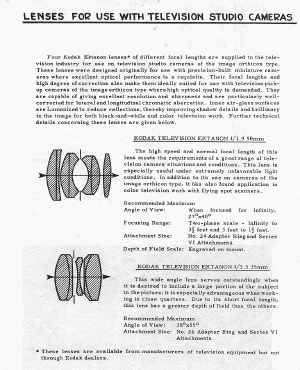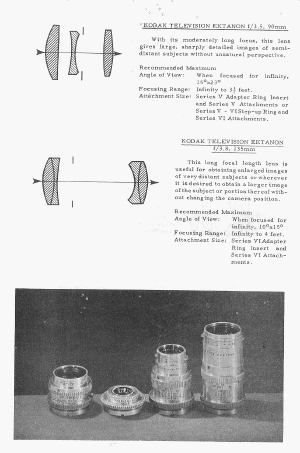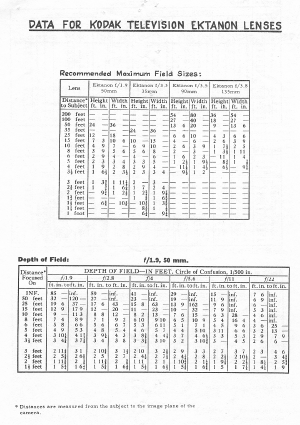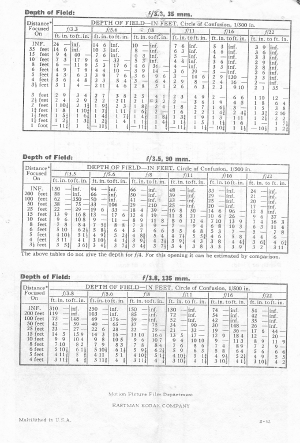|
Rudolph Kinslake
|
|||||||||||||||||||||||||||||||||||
|
Television Ektanon Data Sheets LENSES FOR USE WITH TELEVISION STUDIO CAMERAS Four Kodak Ektanon lenses* of different focal lengths are supplied to the television industry for use on television studio cameras of the image orthicon type. These lenses were designed originally for use with precision-built miniature cameras where excellent optical performance is a requisite. Their focal lengths and high degree of correction also make them ideally suited for use with television pickup cameras of the image orthicon type where high optical quality is demanded. They are capable of giving excellent resolution and sharpness and are particularly well corrected for lateral and longitudinal chromatic aberration. Inner air-glass surfaces are Lumenized to reduce reflections, thereby improving shadow details and brilliancy in the image for both black-and-while and color television work. Further technical details concerning these lenses are given below. KODAK TELEVISION EKTANON f/1.9 50mm The high speed and normal focal length of this lens meets the requirements of a great range of television camera situations and conditions. This lens is especially useful under extremely unfavorable light conditions. In addition to its use on cameras of the image orthicon type, it has also found application in color television work with flying spot scanners. Recommended Maximum Angle of View:When focused for infinity, 27°x40°Focusing Range:Two-phase scale - Infinity to 3 1/2 feet and 3 feet to I 1/2 feet. Attachment Size:No. 24 Adapter Ring and Series VI Attachments. Depth of Field Scale: Engraved on mount.
KODAK TELEVISION EKTANON f/3.3 35mm This wide angle lens serves outstandingly when it is desired to include a large portion of the subject in the picture; it is especially advantageous when working in close quarters. Due to its short focal length, this lens has a greater depth of field than the others.Recommended Maximum Angle of View: 38°x55° * These lenses are available from manufacturers of television equipment but not through Kodak dealers. ' KODAK TELEVISION EKTANON f/3.5, 90mmWith its moderately long focus, this lens gives large, sharply detailed images of semi-distant subjects without unnatural perspective. Recommended Maximum Angle of View: When focused for infinity, 15°x23° KODAK TELEVISION EKTANON f/3.8, 135mm This long focal length lens is useful for obtaining enlarged images of very distant subjects or wherever it is desired to obtain a larger image of the subject or portion there of without changing the camera position. Recommended Maximum Angle of View: When focused for infinity, 10°x15°
|
|||||||||||||||||||||||||||||||||||
|
Ektra Lenses that also fit RCA and other turrets
The following still camera lenses were documented in the Kodak Reference Handbook - Lenses, Rangefinders and Shutters section, © 1942, 1945. This is the most inclusive edition of this material, encompassing both older and newer models from the late 1930s through 1945. It does not include any information about hardcoating or Lumenizing.
|
|||||||||||||||||||||||||||||||||||




